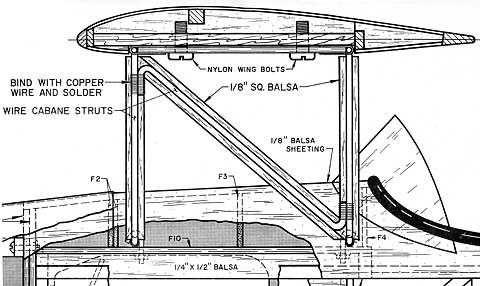How
to Align Cabane Struts on Biplanes and Parasol Aircraft
My Sig Smith Miniplane, like most biplanes, uses cabane struts to mount the wing.
The core of the mount is a plywood plate in the fuselage (F10). The
plywood mounts to 1/4" x 1/2 balsa stock that must be perfectly aligned on both
fuselage sides. If these are wrong then everything that follows will also
be wrong.
There are two brass tubes that are J-bolted and epoxied to the plywood plate.
These must also be perfectly aligned. Into these tubes are epoxied the
four cabane pieces. Each of the cabane pieces is made from 1/8" music wire
and is bent into a Z shape more or less. The arrangement makes a
parallelogram that may or may not be straight, true and level by the time it is
finished.
A diagonal piece of music wire is wire wrapped
and soldered to the cabanes. When this is complete two pieces of brass
plate are wrapped around the top of the cabanes and soldered in place.
Between the brass pieces is another piece of plywood that is epoxied in place.
Assuming the plate and tubes are correct in the fuselage, it is still
possible to have one set of cabanes rotate further forward or aft of the other.
This will result in the wing being lower on that side of the aircraft. In
theory, the diagonal piece will ensure that the cabanes on both sides are
identical. It does not work out that way in practice unless careful
measurements are taken.

Image from Sig Smith Miniplane plans
First I tried to block the fuselage level and perpendicular to the
building surface. That meant dropping a centerline from the fuselage
to the building surface as a reference line. From this line I would have
to go back up to the cabanes to ensure they were aligned properly to the
fuselage and each other.
I messed around with this for about an hour before coming to the conclusion that
I just couldn't do it with any degree of accuracy. Eye-balling it
would have given me close to the same result.
Then I had a brainstorm. I knew that the firewall was perpendicular to the fuselage centerline in both top and side view
so it
could be used as a reference. Here's how I did it:
|
![]()